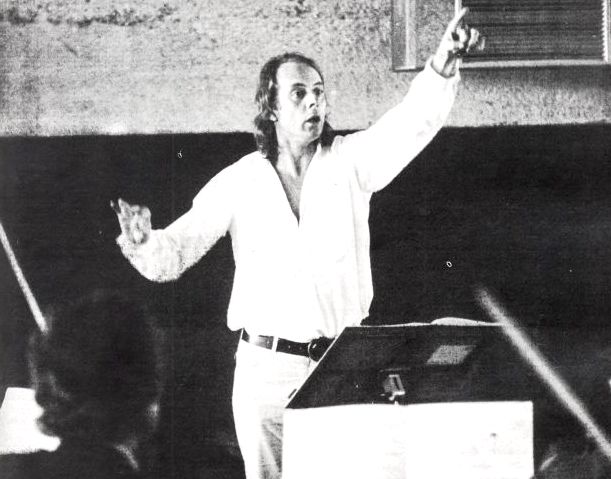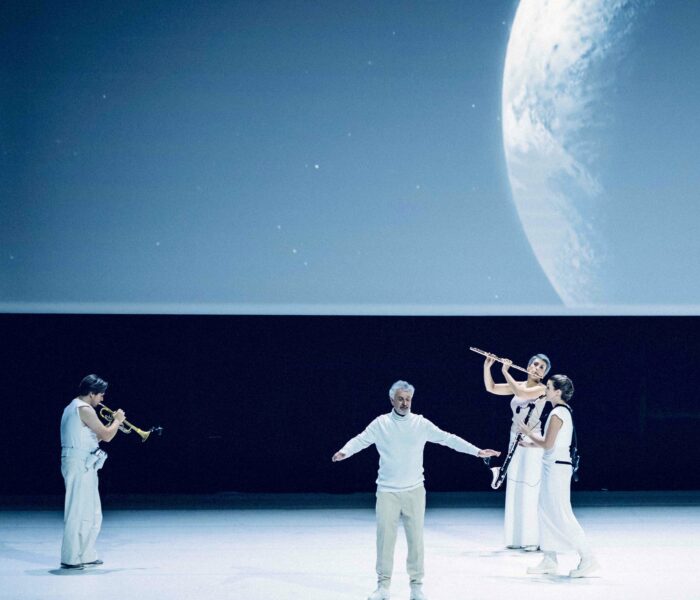Message d’espoir et d’amour lancé vers le ciel, Freitag aus Licht (Vendredi de lumière) de Karlheinz Stockhausen, dédié « À tous les enfants », est donné sur la scène de l’Opéra de Lille par Le Balcon et son chef Maxime Pascal, dans une mise en scène de Silvia Costa.
Après Donnerstag, Samstag et Dienstag – le dernier en date a été joué à la Philharmonie de Paris en octobre 2020 -, Le Balcon poursuit avec la même détermination son projet de l’intégrale des sept journées de Licht avec Freitag (1991-1996) dans lequel Stockhausen dit avoir voulu traduire en musique « les tentations humaines archétypiques ».
Freitag est le jour de la tentation d’Eva (soprano) par Ludon (basse) – alias Lucifer. Frei-Tag (Jour libre) est aussi la journée des enfants, ceux d’Eva à travers l’orchestre des flûtes et clarinettes qu’elle dirige, et ceux de Ludon (chœur d’enfants) qui chantent, formant un joyeux tutti dans le premier acte. Pour autant, ce sont eux qui s’affrontent dans la deuxième partie (Kinder-Krieg) où le synthétiseur/échantillonneur répercute les violences du combat.
Autres présences et émanations des personnages de Freitag aus Licht, Elu (cor de basset) et Lufa (flûte) évoluent dans le giron d’Eva tandis que les Synthibirds (synthétiseurs) sont plutôt dans le camp de Ludon. Le monde d’Eva est blanc et instrumental, qui s’oppose au monde de Ludon, noir et choral.
L’intrigue est la suivante : Ludon propose à Eva de s’unir avec son fils Kaino (baryton) pour procréer ; Eva hésite puis consent à la fin du premier acte. Elle rencontre Kaino un soir au clair de lune et s’unit à lui. Mais la guerre éclate entre les deux factions d’enfants, disséminant ceux d’Eva. Cette dernière se repent et prie… “Obscurité devient lumière”.



Dans Licht, chaque opéra se déroule selon le même rituel, avec le Salut avant le début de la représentation et l’Adieu adressé au public qui quitte la salle ; ces deux moments dans Freitag sont dévolus à l’électronique qui est une des composantes déterminantes de ce spectacle intergalactique.
L’effet du Weltraum, la musique du Vendredi de lumière qui résonne dans le foyer (les 66 premières minutes de la « bande » de Freitag) opère avant même l’entrée dans la salle, nous mettant en condition pour pénétrer dans cette antre sacrée, aussi étrange qu’irrationnelle, imaginée sous tous ses aspects, musical, scénique voire gestuel, par Stockhausen.
Trois strates sonores y sont entendues : celle de l’électronique déjà citée, projetée en continu dans l’espace de la salle (où passe parfois la voix du compositeur) ; celle de l’intrigue déployée en dix « scènes réelles » et traversée par le flux de l’électronique ; et celle des douze « scènes de son » diffusées sur douze canaux et fonctionnant en alternance avec la précédente.
L’idée, déclinant toujours celle de la tentation, est de présenter dix couples d’êtres et d’objets du quotidien alliant mâle et femelle (un homme et une femme, un chien et une chatte, une voiture de course et son pilote, un ballon de foot et une jambe de footballer, une bouche et un cornet de glace, etc.) et de constituer une collection de sons du monde que donne à entendre ce rêveur d’inouïs.
Stockhausen avait prévu des couples de danseurs-mimes pour incarner ces binômes. Silvia Costa met les objets entre les mains des enfants-démiurges. On les voit, en blouses blanches et au niveau supérieur du plateau, actionner ces machines à son et déployer leur énergie créatrice, la chorégraphie de gestes prenant parfois le pas sur la dimension sonore. Au fil des scènes, les rôles s’échangent et les binômes s’hybrident, accusant l’effervescence de ce monde bruitiste, plein de couleurs et de fantaisie, qui tranche avec le cérémonial du monde d’en bas.


La trame du livret constitué par Stockhausen est une juxtaposition de mots sans narration – “jour nuit naissance / sainte nuit – flamme de bougie / pas de temps / comète indique Vendredi-tentation” etc. – délivrant des messages et chantés par les personnages et le chœur d’enfants comme une action de grâce.
« Licht est semblable à une cérémonie marquée par la répétition, l’incantation, la psalmodie », fait remarquer Maxime Pascal qui, en tant que chef, restera toujours invisible! « C’est un bloc, une formule à deux voix qui sont chacune le miroir de l’autre », poursuit-il, évoquant les mélodies de la « super-formule » stockhausienne qui structure l’ensemble du projet de Licht et donne à chaque opéra son contexte harmonico-mélodique et sa forme générale.
La vocalité dans Freitag aus Licht est intrinsèquement liée à l’écriture instrumentale et détachée de toute tradition occidentale. La voix aiguë des enfants (magnifique Maîtrise de Notre-Dame) dans le chœur central du premier acte prend une dimension hymnique, fervente et envoûtante ; on pense au Gesang der Jünglinge du même Stockhausen mais aussi à l’Oresteïa de Xenakis, lorsque les enfants agitent leurs percussions africaines (sorte de maracas) tout en envoyant des messages d’amour (« Emilie Fleury Silvia Costa Olivier Mantei ma petite Joséphine ma petite Markovits… ») à ceux qui les accueillent dans leur maison!
Le chœur est épaulé par l’ensemble de flûtes et clarinettes (les élèves du CRR de Lille superbement préparés) comme le sont les trois voix solistes par le couple flûte et cor de basset (exemplaires Charlotte Bletton et Iris Zerdoud) qui peuvent se substituer aux personnages. Dans un registre souvent tendu vers l’aigu, la voix lumineuse de la soprano française Jenny Daviet assume avec panache toutes les figures que lui dessine le compositeur, inscrivant parfois son chant sur le flux électronique. La basse cubaine Antoine HL Kessel se cantonne quant à lui dans le grave de sa voix richement timbrée, leader du chœur dans lequel il chante avec les garçons.
On pourrait graver dans les annales du chant stockhausenien, le superbe duo d’amour du second acte entre Eva/Jenny Daviet et Kaino/Halidou Nombre (baryton) où les deux personnages recomposent la lune dans la scénographie originale de Silvia Costa. L’écriture vocale regarde davantage vers le monde asiatique (glissades, ondulations, lignes et temps étirés, etc.) et l’émission instrumentale (roulement/roucoulement du baryton) quand flûte et cor de basset soutiennent les voix et dialoguent avec elles. Les deux amants se rejoignent et fondent leur tessiture, accouplement musical des plus sensuels et originaux jamais entendus.
« Repentir » (scène réelle 8) est un autre temps fort où Eva s’agenouille à l’endroit où elle s’est unie à Kaino, chantant et exécutant les gestes d’Inori (œuvre de prière et d’adoration au catalogue du compositeur) qui regarde vers le rite chrétien autant que vers le yoga ou les postures de Bouddha.



La matière est riche, le contenu chargé de symboles et l’imagination sans bord de cette œuvre-monde couvrant quelques trois heures de spectacle que Silvia Costa et l’équipe des costumes (Bianca Deigner) et création lumière (Bernd Purkrabek) parviennent à représenter dans sa beauté plastique, son foisonnement et sa cohérence, tout à la fois. Échappant à la vue du public mais en contact avec les interprètes par le biais des écrans, le chef Maxime Pascal et les forces du Balcon – Augustin Muller et Étienne Démoulin au son, Florent Derex à la projection – travaillent dans l’ombre pour faire éclore la magie de ce spectacle total transcendé par l’imaginaire poétique de Stockhausen.
Michèle Tosi
Opéra de Lille, le 7-11-2022
Karlheinz Stockhausen (1928-2007) : Freitag aus Licht, opéra en un salut, deux actes et un adieu, pour trois voix, trois instruments solistes, orchestre d’enfants, chœur d’enfants, chœur, synthétiseur et électronique. Musique, livret, action scénique et geste de Karlheinz Stockhausen ; Mise en scène, Silvia Costa ; Création lumières, Bernd Purkrabek ; costumes, Bianca Deigner ; projection sonore, Florent Derex ; électronique, Augustin Muller et Étienne Démoulin. Jenny Daviet, soprano, Eva ; Antoin HL Kessel, basse, Ludon ; Iris Zerdoud, cor de basset, Elu ; Charlotte Bletton, flûte, Lufa ; Halidou Nombre, baryton, Kaino ; Sarah Kim et Haga Ratovo, synthibird. Chœur mixte (douze chanteurs) Le Balcon ; Maîtrise Notre-Dame de Paris (chœur d’enfants), les enfants de Ludon ; Élève du Conservatoire à Rayonnement Régional de Lille (orchestre d’enfants), les enfants d’Eva. Danseurs : Rosabel Huguet Dueñas, Le bras ; Susanne Meyer, La bouche, Jean-Baptiste Plumeau, La jambe ; Enfants comédiens : Edgar Cemin, Arsène Jouet, Alexis Mazars, Stéphane Poulet, Marin Rayon, Colette Verdier dirigés par Johanne Carillon. Cheffe de chœur Émilie Fleury ; direction musicale Maxime Pascal.



)



